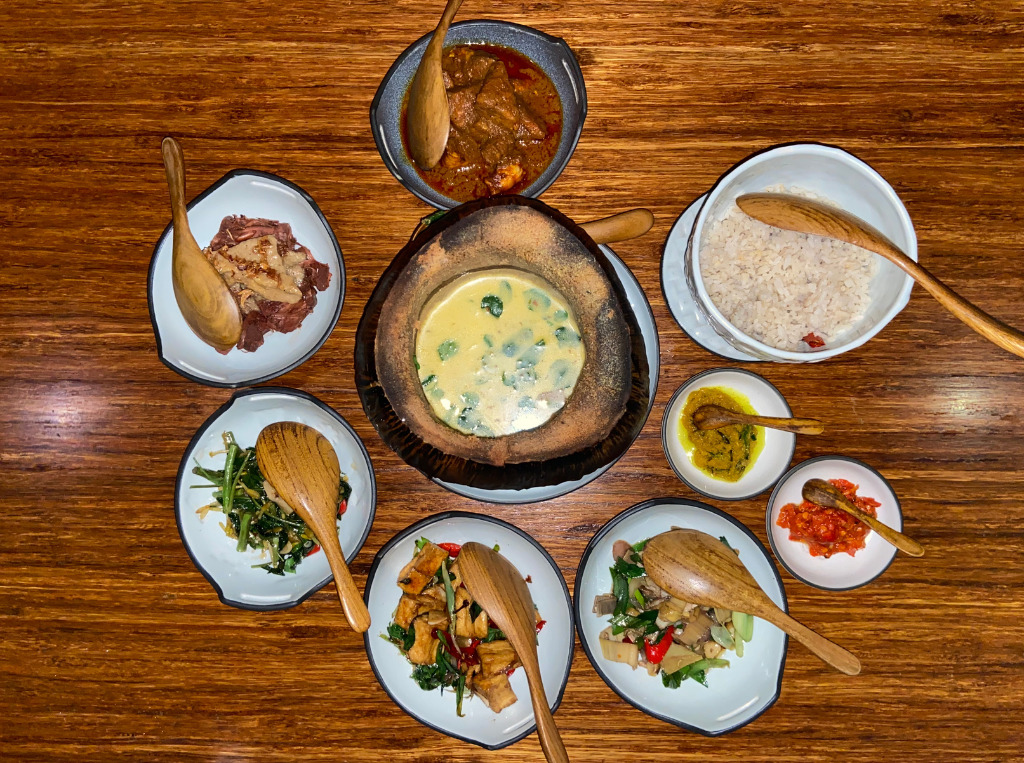Nusantara by Locavore, Bali Review: A Vegan Tasting Menu Fit for the Island of Gods
10 Mins Read
Nusantara, an Indonesian eatery by the world-renowned Locavore restaurant group in Bali, celebrates the indigenous dishes from around the archipelago in a spectacular vegan tasting menu that is not to be missed.
Locavore – which is about to open a new vegetarian restaurant and the second iteration of its flagship eatery (called Locavore NXT) in December – prides itself on sustainability, championing regional ingredients and local producers. It has regularly appeared on Asia’s Best 50 Restaurants List, winning the Sustainable Restaurant Award in 2019.
Nusantara is Locavore’s ode to Indonesia. Located in the centre of Ubud – the town on the foothills of rice fields, coffee plantations and all the greenery Bali has to offer – the restaurant is hard to miss. ‘Nusantara’ is Bahasa Indonesian for “archipelago”, signifying how the restaurant encompasses the flavours, atmosphere and culture of all the different islands and regions of Indonesia. The menu – dotted with dishes from across the country – emphasises this ethos.
Atmosphere and tailoring to vegans
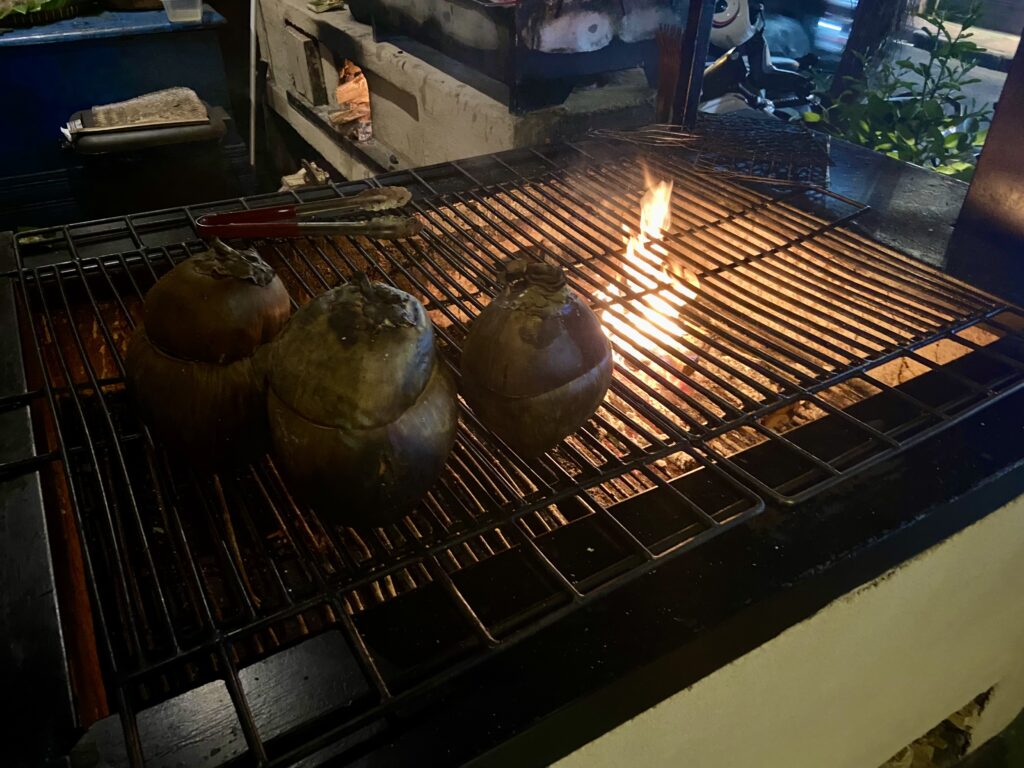
The devil really is in the details with the eatery. They follow up on your booking to confirm your dietary preferences, while a second confirmation email is necessary to finalise your reservation. You can go à la carte or opt for the set menu – I did the latter. While it contains meat, the menu can be tailored to a vegan or vegetarian diet, with certain dishes that don’t appear on the full menu otherwise.
There’s a grill station at the entrance, where coconut husks are used as briquettes, with smoke providing a theatrical entrance experience. There are also whole coconut shells placed atop, which I later found out are used as soup bowls. There’s a red brick wall on the opposite side, and inside, wood is the name of the game. Even the lights are fitted in wooden blocks hanging from the ceiling. You can see parts of the kitchen while seated, and the atmosphere is lively and bustling – though (crucially) not so loud that you can’t hear yourself.
Like many fine-dining establishments on the island, you’ll need to get bottled still or sparkling water at Nusantara – no option for plain tap water. As part of the tasting menu, all dishes come together as it’s a family-style concept.
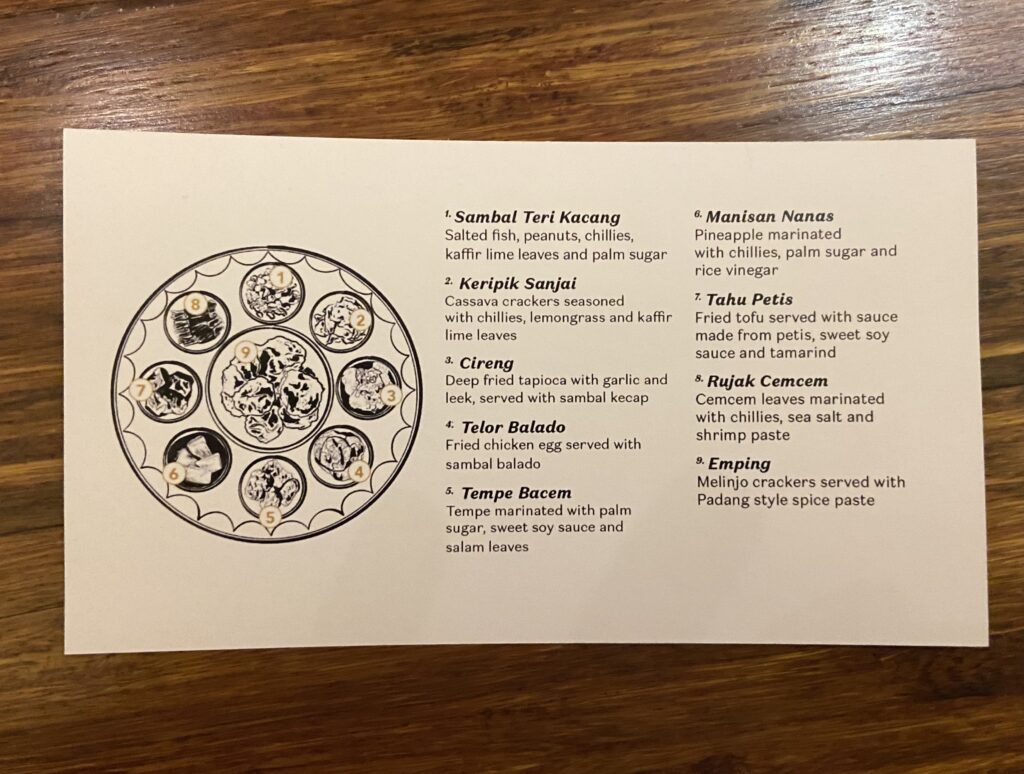
But to my very pleasant surprise, it starts with a bunch of little tasters to get you going. It comes with a wonderfully illustrated info card explaining what each snack is. There are nine items here. The sambal teri kacang (which contains fish) is subbed for a crispy potato option, the telor balado (a chicken egg) makes way for young papaya, the tahu (the local word for ‘tofu’) petis contains fish too and is swapped for a banana curry, while the shrimp paste is removed from the cemcem leaves (a local plant).
A delightfully diverse snack tray
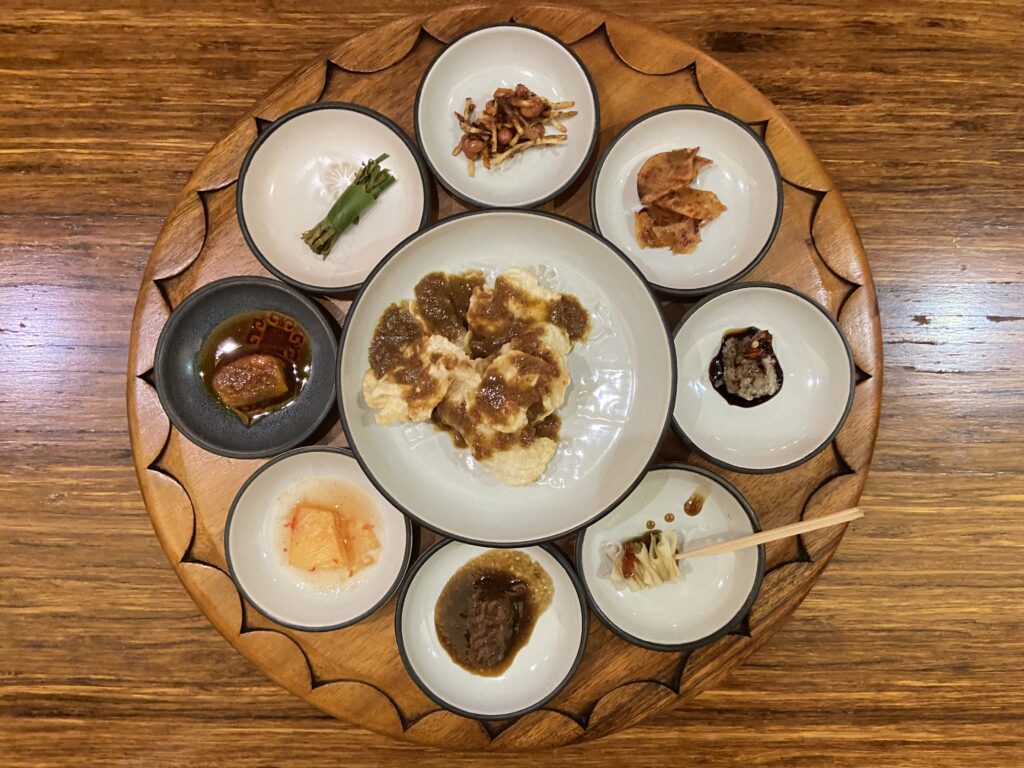
The potatoes are moreish – think garlicky ultra-thin shoestring fries, paired with a sticky sauce that has a hint of a kick rounded out with a delicate sweetness. The cassava crackers have a sweet and spicy combination that really works with the lemongrass and lime leaves.
Next comes the deep-fried tapioca, one of the best parts of the entire meal. It’s doused in spicy kecap manis (Indonesia’s famed sweet soy sauce) that offers a wonderful contrast to the crispy root. From the outside, it’s gooey and sticky, but there’s a delectable crunch and a melt-in-your-mouth texture when you bite in. It reminds me of a very soft tapioca pearl bursting in your mouth, albeit with South Indian flavours.
The thinly shaved papaya layered on a skewer makes for a striking presentation. Its sweet background note balances out the chilli from the tapioca. The sauce itself is very light and complex. The tempeh feels like it has a base of tamarind (though there isn’t any) – continuing the sweet theme, elevated with strong earthy flavours from the salam leaves (Indonesian bay leaves).
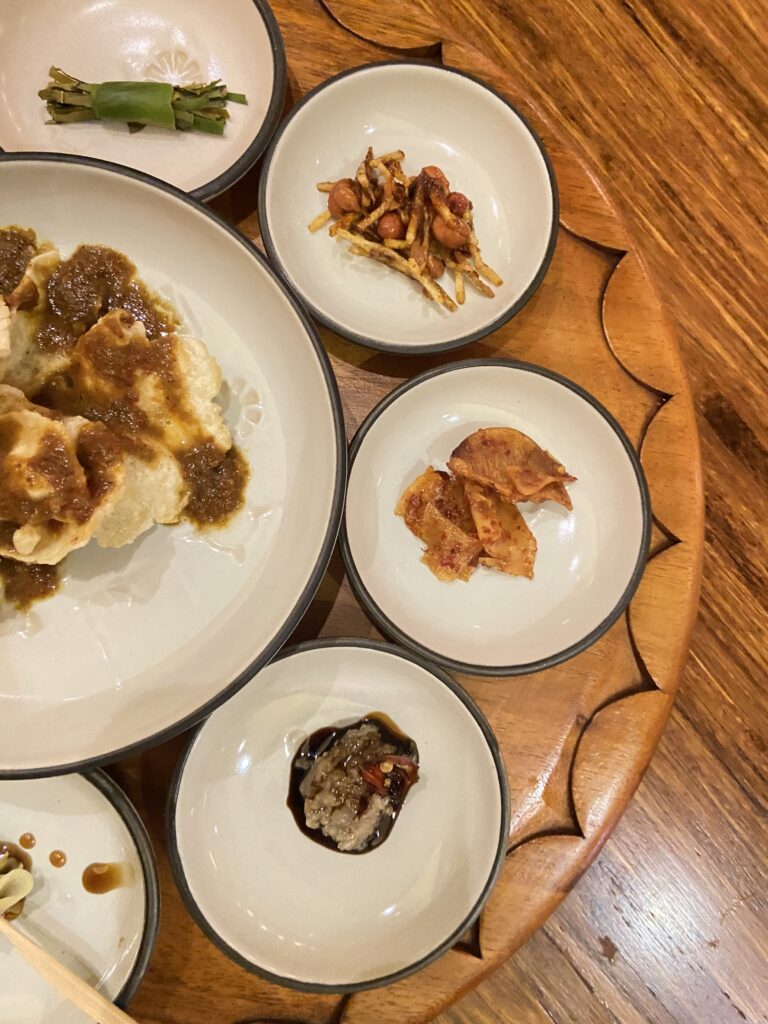
The marinated pineapple is just that – sweet, pickled, a little spicy and simple. The banana curry, however, is magical – the banana isn’t sweet at all, and it’s braised in a gravy reminiscent of an oily North Indian dish heavy on garam masala. The cemcem leaves, meanwhile, are absolutely packed with flavour – pleasantly acidic, slightly sweet and powerfully floral (though I’m not a big fan of the chewy texture).
Emping are crackers made from the seeds of a local plant called melinjo. They aren’t as crunchy as you’d expect, but that’s how they’re supposed to be. The curry sauce really is packed with spices and complements the pleasantly bitter aftertaste of the crackers. However, don’t wait too long to eat these, as the sauce softens the emping rather quickly.
The snacks were a nice touch that prepped my palate for the Indonesian flavours that would continue with the mains.
The rice and sambal
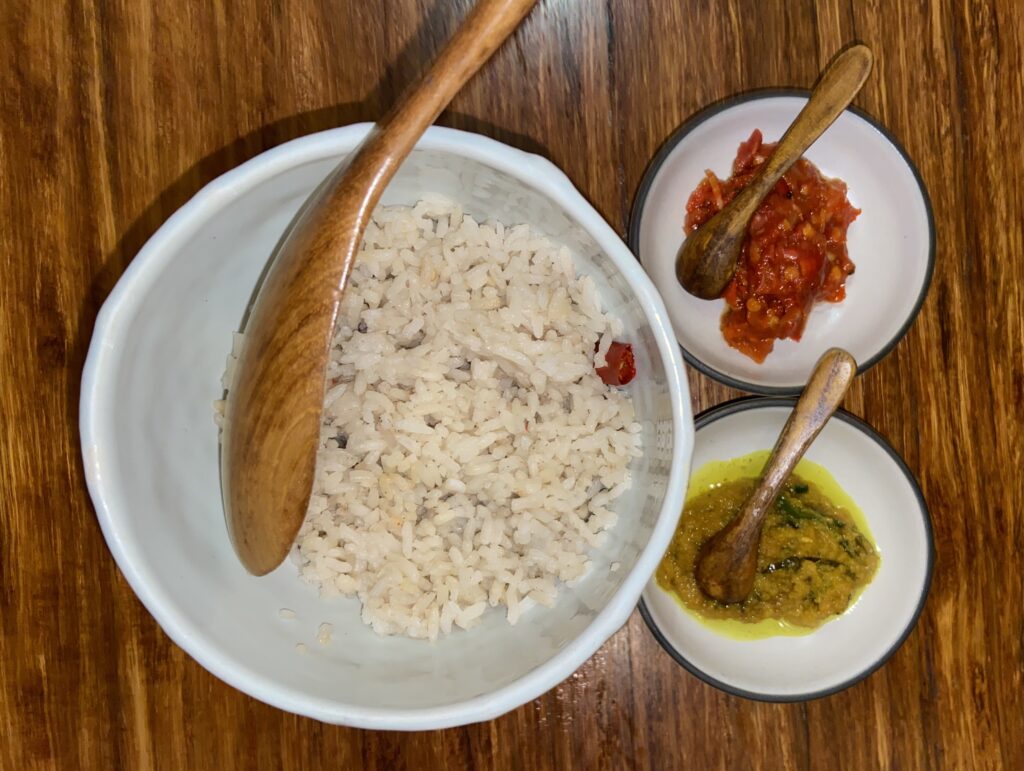
The set menu comprises six mains, a side of rice, two sambals and dessert. The rice itself is maddeningly good. The grains are perfectly cooked and possess a nice bite, and while a delicate background of coconut and pandan helps (along with a whole dried chilli to boot), it’s the flavour of the rice that absolutely shines. I could eat it plain on its own.
Both sambals – Indonesian chilli pastes – are raw (as confirmed by the charming host) and have a base of shallots, garlic, chillies and candlenuts. The greenish-yellow sambal rapah, which hails from West Nusa Tengarra, is heavy on turmeric (both the root and leaves) and salt. In terms of the mouthfeel, this almost feels like a curry paste. It’s not too spicy, but definitely feels like something you need to complement other dishes with.
The Sumatran red sambal tuktuk, on the other hand, is much spicier, and comprises tomatoes, Sumatran Andaliman peppers, tomatoes and torch ginger. The texture is coarser and more palatable than the green sambal, as you can almost pick out the chilli skins. It’s also slightly astringent and not unlike a few other sambals I’ve tried, but I much prefer this one over the green.
Tempeh, tofu and all the vegetables in between
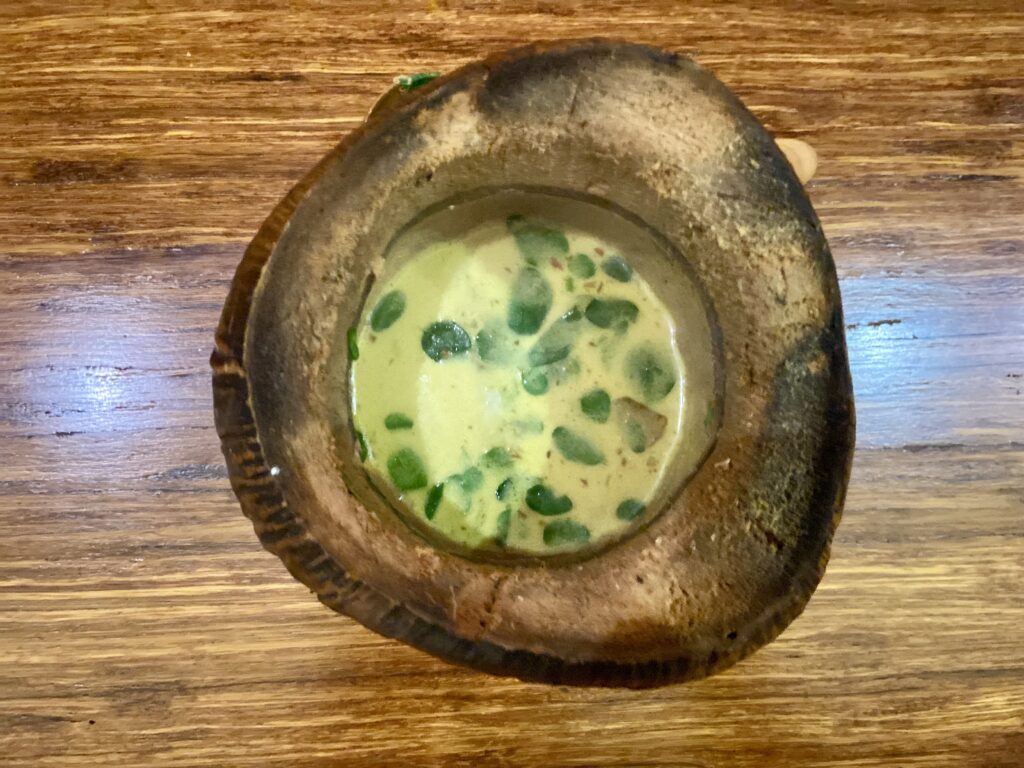
Next up: a local delicacy: moringa leaf soup, which is a standout both visually and flavour-wise. It’s served in those burnt whole coconuts I mentioned above – the soup is poured into these and reheated before being served. There’s such a brilliant contrast of textures at play here, with chunks of both young and aged coconut floating around. The longer the soup sits, the more coconutty it gets – and that can only ever be a good thing.
Oseng jantung pisang – the banana blossom dish – is loud. It’s heavy on soy and garlic, and all the better for it. It evokes memories of addictive takeaway stir-fries, with a fleeting sweetness at the back end. The leeks prove to be an excellent addition, and the sambals are not needed here– it works best on its own, with some rice.
Like the above, the water spinach dish – kangkung bunga pepaya – comes from Sulawesi and is soy-forward too, but with the garlic toned down and some added bitterness thanks to the papaya blossom and turmeric leaves. This dish is really pleasant and even better with rice and a dollop of the green sambal.
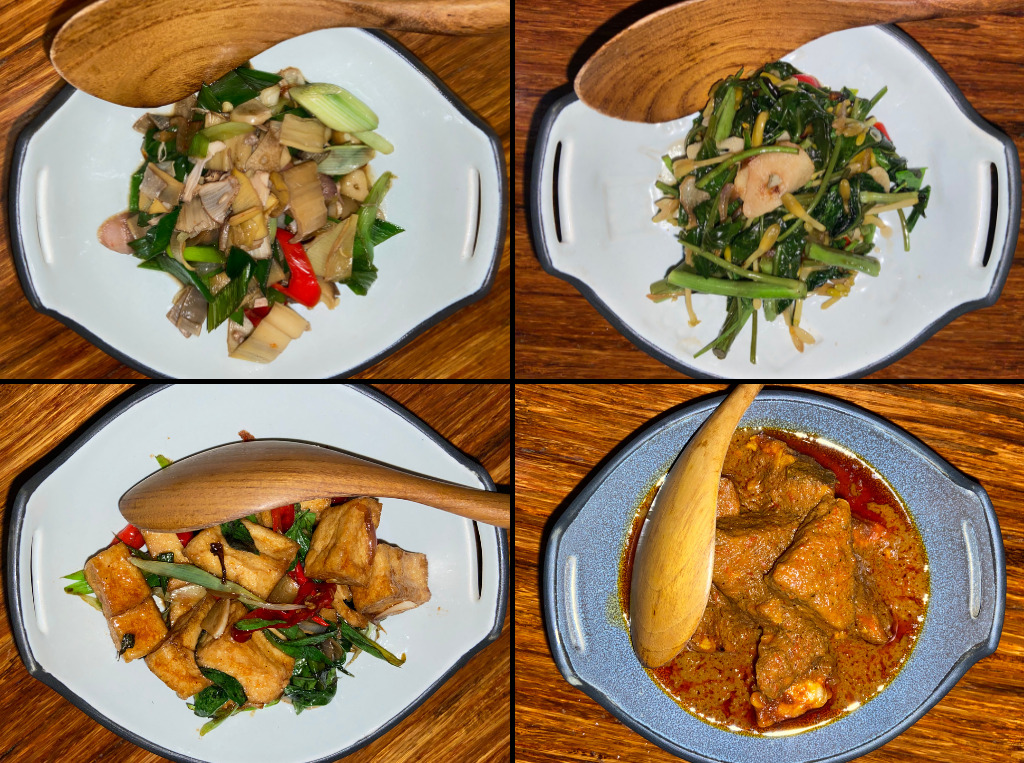
On to the tofu stir-fry, then. You know when you can taste a food’s freshness? Yeah, this tofu is spongy with a melt-in-your-mouth texture – but unlike silken tofu, which collapses – and has a light soy and chilli dressing to help it along. The true star, however, is the lemon basil, which amp up the refreshing quality of the dish. Have it with the red sambal to make it all the more worthwhile.
The tempeh feels like it’s braised in the same fat-forward and warmly spiced sauce the banana curry was cooked in. It’s quite heavy on its own, but the rice balances out the richness. This is one dish that works well with both sambals, but the green one takes the (soybean) cake – though I do have to say the portion felt almost excessive for a tasting menu. Just this tempeh and a side of rice could make for a light dinner.
Finally, there’s a jackfruit dish, gudek nangka, inspired by the Javanese city of Yogyakarta. Purely by appearance, you can tell it’s a complex dish. It’s young jackfruit braised with shallots, galangal, coriander seeds, salam leaves, palm sugar, coconut water and more salam leaves. It’s topped with a slab of fried tofu stewed in coconut milk. This dish has deep flavours and a hint of sweetness; the restaurant recommends that you eat it with one of the sambals, and it works fantastically with the green one.
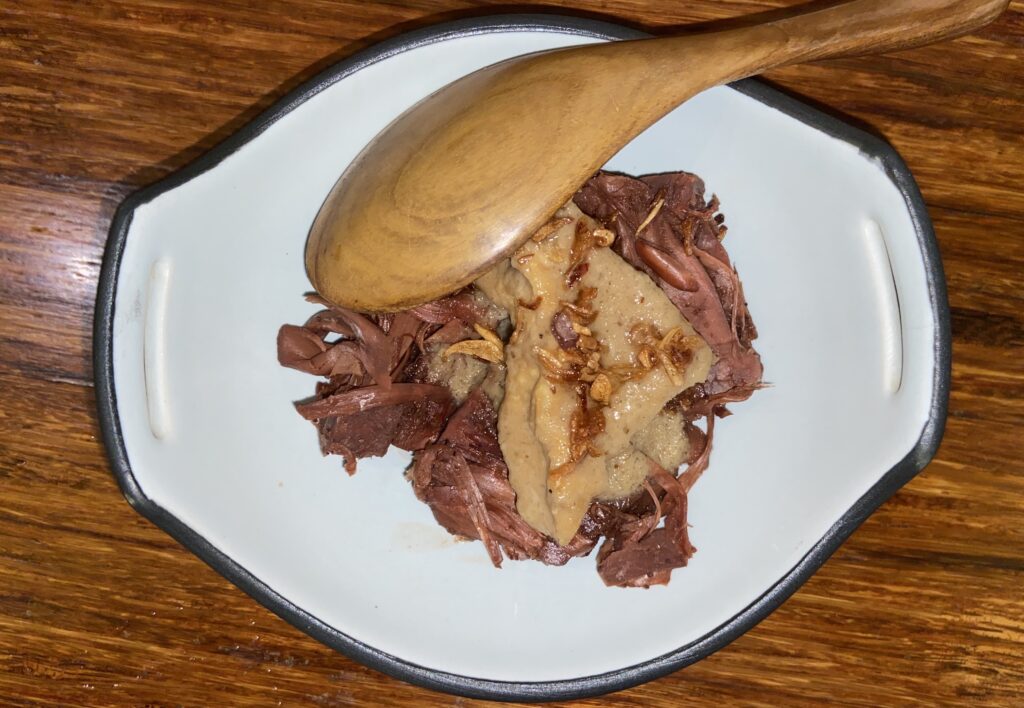
A glorious dessert
I’m not a big fan of liquid desserts, but Nusantara’s take on the street food classic, Es Cendol, blew me away. It features a base of pandan-infused coconut milk sweetened with palm sugar, with floating bits of green rice flour jelly and ripe jackfruit. There’s something about the combination of pandan and coconut milk that makes this taste like kheer, which is a (usually) dairy-based Indian rice pudding that is typically cooked for a long time.
The jelly itself is pretty neutral in flavour; it’s present more for the texture. The mature yellow jackfruit is such a nice surprise – it’s sweet and chewy and succulent with notes of fermented apple and banana, reminiscent of the red papaya that comes in canned fruit cocktail (I mean this in the best way). Together, the brightness of the jackfruit, the creamy nuttiness of the coconut milk, and the texture of the grass really meld together so well. This is a marvellous dessert – which you might be able to tell by the fact I’ve used up two whole paragraphs to describe this.
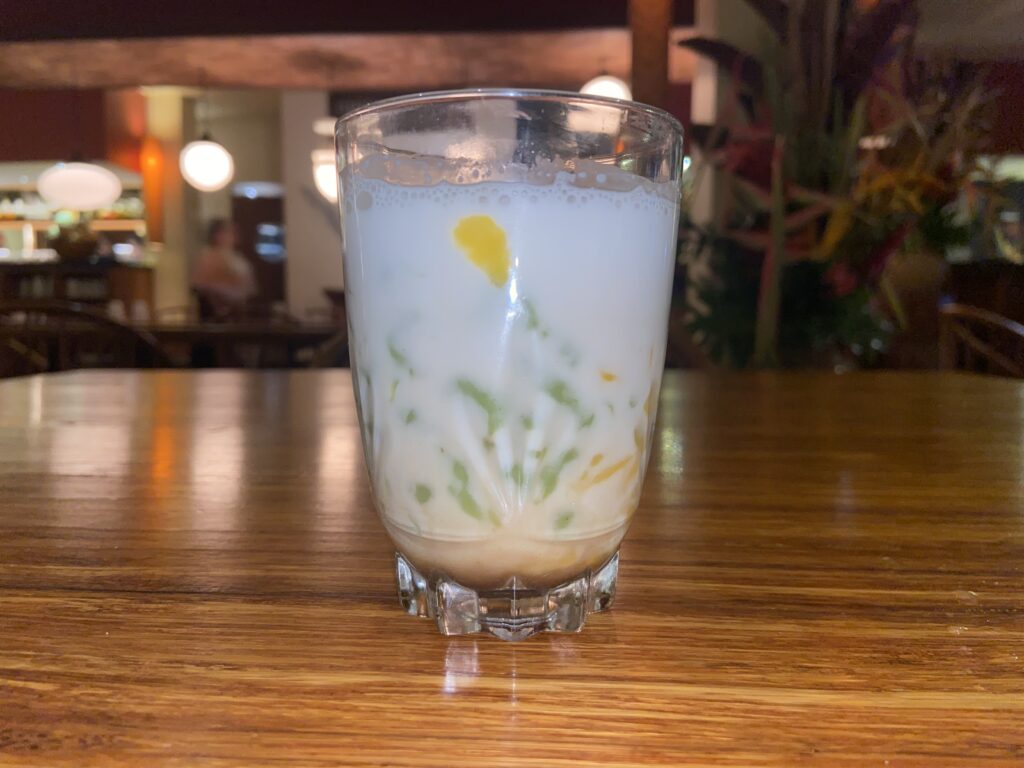
Final thoughts on Nusantara
Nusantara is a special place to go for an area of Bali where you’re spoilt for choice. Of course, it’s upscale fine dining, and you’ll spend 10 times more than you would at a warung (the small family-owned eateries that dot Indonesian towns), but for 450,000 IDR (about $28) plus taxes, the quality, range and sheer amount of food is an absolute bargain anywhere and well worth the detour.
For me, the moringa soup, the banana blossom stir-fry, the braised tempeh, and dessert were the standouts. Note: if you’re not going for the set menu and have a sweet tooth, I would recommend trying Dadar Gulung, which are pandan-infused rice flour crepes filled with sweetened desiccated coconut.
I have to be honest: this was a lot of food for one person and I was almost uncomfortably (yet happily) full. These are very generous portions, so show up hungry! That said, Nusantara has a very diverse range of flavours and offers something for everyone – bar maybe the pineapple, everything is super inventive and nothing feels boring.
If you don’t have the time to visit the over 17,500 islands in Indonesia (and who does?), Nusantara is the ideal place to sample their diverse culinary identity (especially since the namesake city is the country’s would-be capital).
Nusantara by Locavore is located at Jl Dewisita No 09C, Ubud, Kabupaten Gianyar, Bali 80571. It’s open noon to 2:30pm and 6pm to 9:30pm on most days, and noon to 9:30pm on Mondays and Thursdays. Reservations are recommended.

